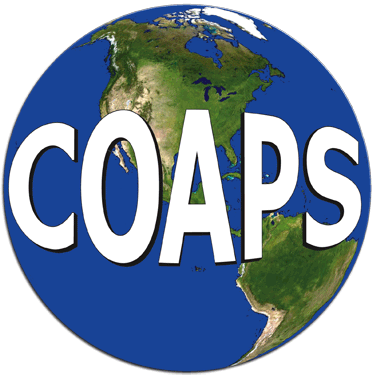MarineFlux
The MarineFlux project aims to establish a user-friendly web access point for the dissemination of turbulent air-sea fluxes and the essential ocean and climate variables (EOV/ECV) required to estimate the fluxes from surface in-situ platforms. The service presently includes fluxes derived from the International Comprehensive Ocean-Atmosphere Data Set (ICOADS), the Shipboard Automated Meteorological and Oceanographic Systems (SAMOS) initiative, and select flux datasets from NOAA expeditionary cruises. In addition to flux observations, MarineFlux strives to include extensive metadata to support discovery, search, access, and application for a wide range of users. The primary data access service supported by MarineFlux is ERDDAP. Additionally, MarineFlux provides an interactive data visualization tool, the MarineFlux Explorer, to support analysis of the in-situ observations alongside select satellite datasets.

Acknowledgements

The MarineFlux project is supported by NOAA's Climate Program Office, Climate Observations and Monitoring Program via award NA21OAR4310262.

The project also acknowledges developers from the NASA Jet Propulsion Laboratory for providing the COVERAGE Data Viewer for infusion into the MarineFlux user interface. The COVERAGE Data Viewer was developed as part of the NASA Physical Oceanography ACCESS/OIIP and NASA ESDIS COVERAGE projects.
Data
Presently, the MarineFlux project is providing flux observations from three sources, each of which can be accessed via our ERDDAP service.
Shipboard Automated Meteorological and Oceanographic System (SAMOS) initiative.
Bulk air-sea fluxes derived from 1-minute interval underway observations from research vessels contributing weather and ocean observations to the SAMOS initiative. The dataset includes all the input variables and the relevant output variables of bulk flux calculations using the Smith 1988 (S88), 2023 update of Bourassa et al (B23), and COARE version 3.6 (C36) algorithms. The dataset includes along-cruise track fluxes from 47 RVs for the period 2005-2024 (noting that not every vessel was operating during all of these years). When redundant instruments exist, the sensors used for calculations are chosen based on the amount of good data available, determined on a per day basis, using an updated method of the one described in Smith, S. R., N. Lopez, and M. A. Bourassa, 2016: SAMOS air-sea fluxes: 2005-2014. Geoscience Data Journal, 3, 9-19, https://doi.org/10.1002/gdj3.34.
International Comprehensive Ocean-Atmosphere Data Set (ICOADS).
Air-sea fluxes derived using three common bulk formulas from a subset of the International Comprehensive Ocean-Atmosphere Dataset (ICOADS) R3.1.0 (1990-2014; https://doi.org/10.5065/D6ZS2TR3) and R3.0.2 (2015-2020; https://rda.ucar.edu/datasets/dsd548003/). Fluxes are derived from ship-based and mooring-based observations and are available for the period 1990-2020. These fluxes are derived from individual marine weather and ocean reports and are provided at the time and location of the original observations. Flux algorithms run include the Smith 1988 (S88), the 2023 update of Bourassa et al (B23), and COARE version 3.6 (C36). For ICOADS, fluxes are derived both with and without the application of bias corrected air temperature values provided by the National Oceanography Center (Morice, C. P., Berry, D. I., Cornes, R. C., Cowtan, K., Cropper, T., Hawkins, E., Kennedy, J. J., Osborn, T. J., Rayner, N. A., Rivas, B. R., Schurer, A. P., Taylor, M., Teleti, P. R., Wallis, E. J., Winn, J., and Kent, E. C.: An observational record of global gridded near surface air temperature change over land and ocean from 1781, Earth Syst. Sci. Data Discuss. [preprint], https://doi.org/10.5194/essd-2024-500, in review, 2024).
NOAA Physical Science Laboratory (PSL).
The PSL dataset contains hourly direct and bulk turbulent fluxes from 55 cruises spanning over 31 years, including the historical data from 12 cruises done in the 1990's and 9 cruises of the PACS/EPIC dataset. Fluxes are derived using observations from NOAA PSL sensors (most accurate) and the ship permanent sensors (less accurate) and include eddy covariance and inertial dissipation methods of estimating fluxes along with estimates from COARE 3.6 bulk air-sea flux algorithm. Wave parameters were not used as input to COARE since they were either unavailable or not consistently available on all projects. True water-relative wind speed was used as input to COARE when available; otherwise, when not available the true wind speed was used instead. Sensible heat flux was computed from vertical velocity - sonic temperature covariance. The humidity contribution to sonic temperature was removed using the bulk latent heat flux. Data collected from these cruises are critical for supporting the study of physical oceanography, air-sea interaction, tropical meteorology, as well as global weather and climate variability and predictability. This includes improvement to our fundamental understanding of these processes in the ocean and their influence around the globe including the Continental United States. The data will also support improvement and validation of prediction models including parameterizations.
Data Visualization & Access Portals
MarineFlux Explorer Portal (Alpha version)
Interactive Data Visualization Tool
MarineFlux Explorer (Alpha version)
marineflux-explorer.coaps.fsu.edu
Public Facing
MarineFlux ERDDAP Portal (Beta version)
Easier access to scientific data
MarineFlux ERDDAP (Beta version)
marineflux-erddap.coaps.fsu.edu/erddap
Public Facing
Contact
MarineFlux Team at FSU:
- Shawn Smith - PI
- Mark Bourassa - Co-I
- Amanda Lovett - Lead programmer
- Michael McDonald - Systems and web administrator
- Kristen Briggs - QC and Metadata
- Tejas Vedagiri – Graduate Student, User interface developer
- Marc Castells - Graduate student, SAMOS fluxes
- Ethan Wright – Graduate student, Triple-collocation uncertainty analysis
- Sabrina Polynice - Undergraduate student, ICOADS QC
- Lauryn Fox - Undergraduate student, ERDDAP testing, uncertainty analysis
Collaborators and contributors
- Ludovic Bariteau, NOAA PSL
- Thomas Cram, NCAR
- Zaihua Ji, NCAR
- Elizabeth Kent, NOC – Southampton, UK
- Flynn Platt, NASA JPL
- Joe Roberts, NASA JPL
- Vardis Tsontos
Survey Results
TBD